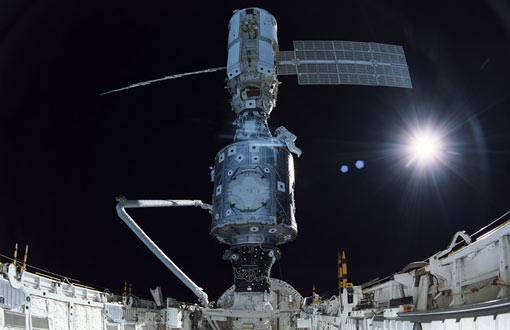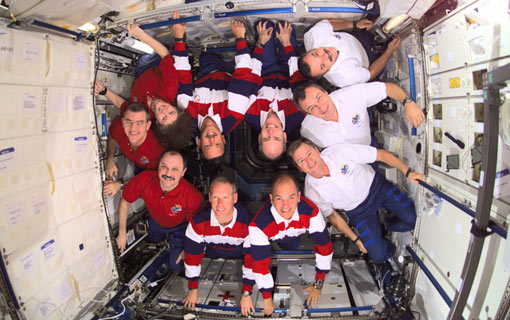You are hereBlogs / WcP.Scientific.Mind's blog / Zarya, 1st launched module of International Space Station (ISS), lifted into orbit 10 years ago on 20Nov1998
Zarya, 1st launched module of International Space Station (ISS), lifted into orbit 10 years ago on 20Nov1998

(quote)
Last month marks the 10th anniversary of the first launched module of the International Space Station (ISS). The module Zarya was lifted into orbit on November 20th, 1998 by a Russian Proton rocket lifting off from Baikonur, Kazhakstan. In the decade since, 44 manned flights and 34 unmanned flights have carried further modules, solar arrays, support equipment, supplies and a total of 167 human beings from 15 countries to the ISS, and it still has a ways to go until it is done. Originally planned to be complete in 2003, the target date for completion is now 2011. Aside from time spent on construction, ISS crew members work on a good deal of research involving biology and physics in conditions of microgravity. If humans are ever to leave the Earth for extended periods, the ISS is designed to be the place where we will discover the best materials, procedures and safety measures to make it a reality.

The Expedition Three (white shirts), STS-105 (striped shirts), and Expedition Two (red shirts) crews assemble for a group photo in the Destiny laboratory on the International Space Station on August 17th, 2001.

Blanketing clouds form the backdrop for this 70mm scene of the connected Zarya and Unity modules after having been released from Endeavour's cargo bay a bit earlier on December 4th, 1998. Six crew members, who had earlier spent the majority of their on-duty mission time working on the tandem of space hardware, watched the joined modules from Endeavour in a survey and fly-around mode.

Astronaut C. Michael Foale, Expedition 8 commander and NASA ISS science officer, equipped with a bungee harness, exercises on the Treadmill Vibration Isolation System (TVIS) in the Zvezda Service Module on the ISS on April 12th, 2004.

The Canadarm2 (center) and solar array panel wings on the International Space Station are featured in this image photographed by a crewmember during the mission's first planned session of extravehicular activity (EVA) while Space Shuttle Endeavour (STS-118) was docked with the station on August 11th, 2007.

A close up view of a water droplet on a leaf on the Russian BIO-5 Rasteniya-2/Lada-2 (Plants-2) plant growth experiment, which is located in the Zvezda Service Module on the ISS. Photo taken on March 9th, 2003.

Astronaut Carl E. Walz, Expedition Four flight engineer, catalogs canisters of water in the Zvezda Service Module on the International Space Station on March 11th, 2002.

The ISS, seen following undocking at 1:13 p.m. (CST), December 9, 2000. This is one of the first images of the entire station with its new solar array panels deployed. Before separation, the shuttle and space station had been docked to one another for 7 days. Endeavour moved downward from the space station, then began a tail-first circle at a distance of about 500 feet. The maneuver, with pilot Michael J. Bloomfield at the controls, took about an hour.
After six months in orbit, space station astronauts land safely in Kazakhstan (+video)
After six months in orbit, space station astronauts land safely in Kazakhstan (+video)
The team of Russian, Dutch, and American astronauts touched down in a Soyuz space capsule.
The Soyuz spacecraft landed on Central Asian steppes of Kazakhstan at 4:14 a.m. EDT (0414 GMT) to return NASA astronaut Don Pettit, Russian cosmonaut Oleg Kononenko and Dutch astronaut Andre Kuipers back to their home planet. "Everything is good, we feel great," Kononenko radioed Russia's Mission Control Center just before landing.
In a blog post describing his final day in space, Pettit reflected on the impact of his months-long mission, and encouraged humanity to keep pushing the boundaries of space exploration. "On Earth, the frontiers opened slowly," Pettit wrote. "The technology of sailing was known and advanced for over a thousand years before the Earth was circumnavigated. Such bold acts require the technology, the will, and the audacity to explore. Sometimes you have one, but not the others. I only hope that my small efforts here, perhaps adding one grain of sand to the beach of knowledge, will help enable a generation of people in the future to call space 'home.'"
Pettit, Kononenko and Kuipers made up half of the station's Expedition 31 crew. During their stay at the orbiting laboratory, the spaceflyers rolled out the welcome mat for the first commercial spacecraft to visit the station. SpaceX's unmanned Dragon capsule was launched to the International Space Station on a test flight to demonstrate the spacecraft's ability to carry cargo to and from low-Earth orbit. As Dragon approached the station, Pettit and Kuipers used the outpost's robotic arm to pluck it from space and manually park it to the complex. The successful test flight lays the groundwork for NASA to use commercial spaceships to ferry cargo, and one day astronauts, to the space station. SpaceX holds a $1.6 billion contract with the agency for 12 unmanned cargo delivery flights.
(unquote)
Photos courtesy of NASA
Original Source: Boston Globe


















